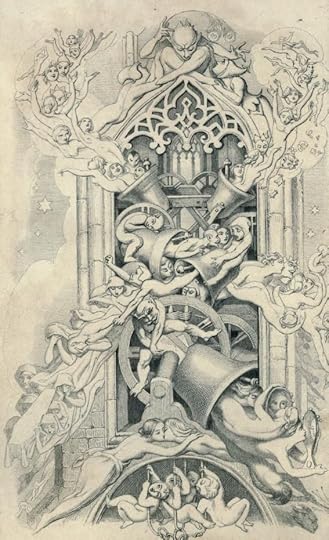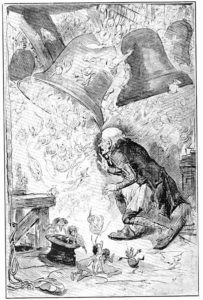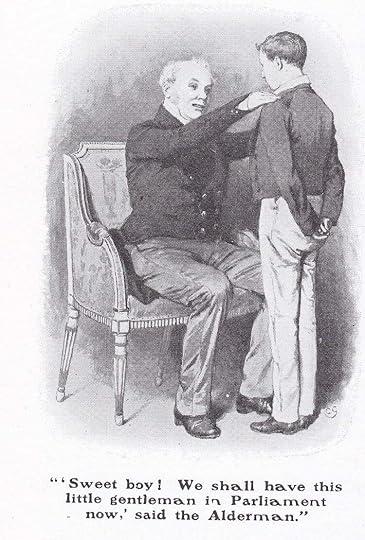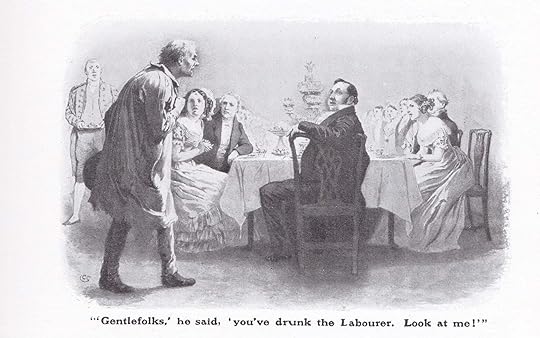Dickensians! discussion

This topic is about
The Chimes
Novellas and Collaborative Works
>
The Chimes (hosted by Petra)
message 351:
by
Milena
(new)
-
rated it 3 stars
Jan 03, 2022 03:48AM
 I agree: these discussions are very enjoyable and helpful. ☺
I agree: these discussions are very enjoyable and helpful. ☺
reply
|
flag
message 352:
by
Bionic Jean, "Dickens Duchess"
(last edited Jan 03, 2022 04:50AM)
(new)
-
rated it 4 stars
Petra - Thank you so much for finding out about Charles Green! He certainly was an elusive fellow, but I do like his understated work. As well as the two you mention, he also illustrated the 4th Christmas book by Charles Dickens in the Pears edition: The Haunted Man And The Ghost's Bargain
 .
.
 .
.
message 353:
by
Bionic Jean, "Dickens Duchess"
(last edited Jan 03, 2022 04:51AM)
(new)
-
rated it 4 stars
Thank you for your excellent summary of the third quarter too Petra. I think this is the best one you've done yet! The story is really moving on now, and the significance of the bells is becoming clearer.
As you say, the ghostly message to Trotty is not as straightforward as the one to Scrooge. Ebenezer Scrooge merely had to mend his ways, whereas Trotty Veck has to learn that he must not condemn the poor who despair and give up. Paul was spot on here "this worthlessness is not merely inherent but is brought about by their own inept conduct and by their unwillingness and inability to bootstrap themselves out of their self-inflicted misery." Specifically Trotty must learn that the poor are not responsible for their condition; it is the fault of those in society who have made it so, in law and by practice.
Trotty Veck is learning self-worth.
As you say, the ghostly message to Trotty is not as straightforward as the one to Scrooge. Ebenezer Scrooge merely had to mend his ways, whereas Trotty Veck has to learn that he must not condemn the poor who despair and give up. Paul was spot on here "this worthlessness is not merely inherent but is brought about by their own inept conduct and by their unwillingness and inability to bootstrap themselves out of their self-inflicted misery." Specifically Trotty must learn that the poor are not responsible for their condition; it is the fault of those in society who have made it so, in law and by practice.
Trotty Veck is learning self-worth.
message 354:
by
Bionic Jean, "Dickens Duchess"
(last edited Jan 03, 2022 04:49AM)
(new)
-
rated it 4 stars
I like the picture by Arthur Rackham very much, Petra! I didn't know he'd made one for this story. Arthur Rackham always drew with such verve. He is acknowledged as one of the best artists of the "Golden Age" of children's book illustrations, and specialised mainly fairy tales and folk tales, (so Teresa, that's where you may have seen his work before :))
I have the specific edition of Rip Van Winkle : With Illustration that Petra mentioned; it's this one .
.
I have the specific edition of Rip Van Winkle : With Illustration that Petra mentioned; it's this one
 .
.
Milena - Yes, you're right, Lilian is signed very clearly here as having become a prostitute. Thanks for the direct reference :)
message 356:
by
Bionic Jean, "Dickens Duchess"
(last edited Jan 03, 2022 04:55AM)
(new)
-
rated it 4 stars
Mary Lou - I like the way you picked up on all the repetition :) As Petra says, it is to emphasise the points about the poor, and the message the goblins of the bells are giving to Trotty. It's quite a deliberate device used, as you say, by Charles Dickens over and over again in this story, to hammer the point home.
The literary name for this, in case anyone is wondering, is anaphora: in rhetoric it means the repetition of a word or phrase at the beginning of successive clauses.
The literary name for this, in case anyone is wondering, is anaphora: in rhetoric it means the repetition of a word or phrase at the beginning of successive clauses.
 Milena, I saw that connection with the drying of the feet as well. If she isn't a streetwalker, she may be a "kept woman" or mistress of one man.
Milena, I saw that connection with the drying of the feet as well. If she isn't a streetwalker, she may be a "kept woman" or mistress of one man.
 I have fun writing up the summaries. Thank you for all the kind words.
I have fun writing up the summaries. Thank you for all the kind words. Milena, that's a wonderful connection (the drying of the feet). That confirms, for me, that poor Lillian was forced into prostitution or, as Rosemarie says, being a kept woman. The poor girl.
I was touched with Meg and Richard's stories in these scenes. They do not marry. Both become sad, tired, despondent people. Without having each other to hold on to and to support each other, they both sink into unhappy, lonely lives.
Meg and Lillian have a deep love between them but are kept apart because of Lillian's forced "employment". Despite the "ill gotten money" that she can earn from her profession, it brings no relief from the poverty and despair, but only adds to it through separation and more loneliness for them both.
So much sadness and despair by removing love and support.
 Here's a couple more illustrations from this section:
Here's a couple more illustrations from this section:I posted this one at the beginning of our read and repeat it now because it fits into this section.
The Chimes by Daniel Maclise

message 361:
by
Bionic Jean, "Dickens Duchess"
(last edited Jan 04, 2022 04:12AM)
(new)
-
rated it 4 stars
It's more precise than that, Rosemarie. There are so many repetitions of lost "Youth and Beauty". Lilian is clearly signalled as a prostitute, not a kept woman. She has lost all dignity and hope.

Meg and Lilian - Charles Green
I believe Charles Dickens put in the Biblical reference at the end of the Quarter, to make sure there was no doubt that this was a "fallen woman" in Charles Dickens's terms, or a "sinful woman" Luke 7:36-50 - not someone's well maintained mistress. She earns money by selling herself; this is referred to earlier in the Quarter as well.
Modern dramatisations are able to make this even clearer, but Charles Dickens was bound by the proprieties of the time.

Meg and Lilian - Charles Green
I believe Charles Dickens put in the Biblical reference at the end of the Quarter, to make sure there was no doubt that this was a "fallen woman" in Charles Dickens's terms, or a "sinful woman" Luke 7:36-50 - not someone's well maintained mistress. She earns money by selling herself; this is referred to earlier in the Quarter as well.
Modern dramatisations are able to make this even clearer, but Charles Dickens was bound by the proprieties of the time.
 That is such a painful situation for Lilian and Meg then.
That is such a painful situation for Lilian and Meg then. This really shows how hard poverty is on single women. Meg is working herself to death on starvation wages and Lilian has degraded herself.
I'm curious how some of the "worthy middle class" reacted to this scene.
message 363:
by
Bionic Jean, "Dickens Duchess"
(last edited Jan 04, 2022 04:13AM)
(new)
-
rated it 4 stars
Yes, Charles Dickens really did go as far as he dared. Presumably the "worthy middle class" also looked askance at his reforming work in "Urania Cottage". Charles Dickens makes a very good case with The Chimes, for the poor to have self-respect, and not to condemn those who have given up all hope because of their situation e.g. Lilian, or Trotty when he criticised women who killed themselves in despair by throwing themselves in the river.
 Milena wrote: "I also think that Dickens is hinting that Lilian is a prostitute. The sentence that makes me think that she's a prostitute is: "He suffered her to sit beside His feet, and dry them with her hair." ..."
Milena wrote: "I also think that Dickens is hinting that Lilian is a prostitute. The sentence that makes me think that she's a prostitute is: "He suffered her to sit beside His feet, and dry them with her hair." ..."That's good to know Milena. I've just finished the third quarter and I'm a bit lost. I don't understand some of Dickens language. I read a lot of his novels in my teens but I seem to be finding it harder to get to grips with now. Must be old age :)
message 368:
by
Bionic Jean, "Dickens Duchess"
(last edited Jan 05, 2022 03:25AM)
(new)
-
rated it 4 stars
 Bionic Jean wrote: "
Bionic Jean wrote: "Trotty in the Belfry - George Alfred Williams
(Image found by Petra - I love this painting!)"
Holy cow! That one makes it look like Trotty is one misstep away from hellfire and brimstone!
 The Williams painting really captures the wind. The loud sound of the bells, the appearance of the spirits, and the fearful images of his daughter's future must be overwhelming Trotty's senses.
The Williams painting really captures the wind. The loud sound of the bells, the appearance of the spirits, and the fearful images of his daughter's future must be overwhelming Trotty's senses.
 Jean, thank you!
Jean, thank you! I found the image, but I also lost it and couldn't find it again to post it. Thank you, Jean, for finding it again and bringing it here for us all to enjoy.
Paul & Connie, this is a marvellous painting, I agree. It really does bring up to the reader the fact that Trotty has to face his demons.
This painting is elusive. It's a shame, really. It really gets to the mood in the Belfry.
 Teresa wrote: "That's good to know Milena. I've just finished the third quarter and I'm a bit lost. I don't understand some of Dickens language. I read a lot of his novels in my teens but I seem to be finding it harder to get to grips with now. Must be old age :) "
Teresa wrote: "That's good to know Milena. I've just finished the third quarter and I'm a bit lost. I don't understand some of Dickens language. I read a lot of his novels in my teens but I seem to be finding it harder to get to grips with now. Must be old age :) "Ha ha ha Teresa, if you are a bit lost sometimes, just imagine me. But I treasure every tip that I find in the discussion. :-P
 Paul wrote: " Holy cow! That one makes it look like Trotty is one misstep away from hellfire and brimstone!"
Paul wrote: " Holy cow! That one makes it look like Trotty is one misstep away from hellfire and brimstone!"Great image Jean and Petra.
Paul, that is quite a nightmarish company for poor Trotty. :-D
 Petra wrote: "Shirley (stampartiste) wrote: " It was so obvious that Dickens was living and feeling this story as it came out of his heart and onto the paper. Only his life experiences could have affected his wr..."
Petra wrote: "Shirley (stampartiste) wrote: " It was so obvious that Dickens was living and feeling this story as it came out of his heart and onto the paper. Only his life experiences could have affected his wr..."Thank you, Petra, for the reference to John Forster's book on Dickens. I will try to find it locally.
 Love that painting! And I do like Maclise as well.
Love that painting! And I do like Maclise as well.Thanks for all the images, really adds to the read.
 What really saddened me about Lillian is that she sacrificed her life and her virtue rather than be a financial burden on Meg. That must have taken such great courage!
What really saddened me about Lillian is that she sacrificed her life and her virtue rather than be a financial burden on Meg. That must have taken such great courage!I was reading recently about the "prostitutes" that Jack the Ripper killed during his reign of terror. The current thought is that these women (with the possible exception one of them) were merely poor women who lived and slept on the street. Alone, women had few to no options in life. I admire Dickens so much for exposing the degradation of poor women in Victorian England.
 Petra and Jean... the illustrations you're finding and posting here bring so much life to this story. Thank you!
Petra and Jean... the illustrations you're finding and posting here bring so much life to this story. Thank you!
 Shirley (stampartiste) wrote: "What really saddened me about Lillian is that she sacrificed her life and her virtue rather than be a financial burden on Meg. That must have taken such great courage!
Shirley (stampartiste) wrote: "What really saddened me about Lillian is that she sacrificed her life and her virtue rather than be a financial burden on Meg. That must have taken such great courage!I was reading recently about..."
I agree completely. Women really had no options in life if left desperate. It always amazes me how low women were considered to be. Makes me thankful we live in the times we do.
 I'm so glad you added that Milena, because I was also going to say I'm certain Lilian became a prostitute. I thought it from the moment she said "Richard, I have fallen very low". Given the Victorian taboos regarding prostitution, that is as close as Dickens could come to saying what Lilian's profession truly was. And then the wiping of the feet reference confirmed it for me.
I'm so glad you added that Milena, because I was also going to say I'm certain Lilian became a prostitute. I thought it from the moment she said "Richard, I have fallen very low". Given the Victorian taboos regarding prostitution, that is as close as Dickens could come to saying what Lilian's profession truly was. And then the wiping of the feet reference confirmed it for me.I've always thought Mary Magdalene was the woman who wiped Jesus's feet too, but when I tried to look it up just now, it is a bit more complicated. Here's the pertinent bible section from Luke 7:37-38
When one of the Pharisees invited Jesus to have dinner with him, he went to the Pharisee’s house and reclined at the table. A woman in that town who lived a sinful life learned that Jesus was eating at the Pharisee’s house, so she came there with an alabaster jar of perfume. As she stood behind him at his feet weeping, she began to wet his feet with her tears. Then she wiped them with her hair, kissed them and poured perfume on them
The woman is unnamed in that chapter, though it seems obvious the "woman leading a sinful life" was a prostitute. Especially if you read the rest of Luke Chapter 7, because it makes clear that her sin is significant. The next Chapter of Luke (chapter 8) begins with Mary Magdalene travelling with Jesus and the Disciples, and so over the years many artists, and scholars have assumed it was Mary Magdalene wiping Jesus's feet in the previous chapter.
For the purposes of this story though, whether it was her or not in that bible section, I think Dickens means to infer Lilian was a prostitute simply because the woman at the dinner with the Pharisees certainly was one.
message 381:
by
Bionic Jean, "Dickens Duchess"
(last edited Jan 05, 2022 07:34AM)
(new)
-
rated it 4 stars
Bridget - You are right!
Following Milena's reference, in my comment 361 LINK HERE
(under the illustration) I had quoted exactly the same passage in Luke's Gospel. Bearing in mind the doubts of Rosemarie and Petra, I realised the two-fold problem. I had had the same thoughts as you, because current Biblical studies have gone into the different Marys (I think there are at least 3) and there are scholarly books on this which are inconclusive.
However, the point is that at the time Charles Dickens was writing, the accepted view was much simpler and unquestioned. His contemporary readers would have known instantly by this allusion that Lilian had become a prostitute, as you said. Only now are we tempted to put a "kinder" light on this.
The illustration is from a little later of course, and we must not deduce Charles Dickens's intentions from his later illustrators of e.g. his novels, such as Harry Furniss (beautiful though they may be). In the same way, Charles Green's illustration is merely proof that the public continued to interpret Lilian's condition in the same way (meaning she was now a prostitute) by the time of the 1910s.
But it is extremely important for modern readers to remember that there is no ambiguity here, merely what was allowed to be said out loud for propriety. It is a typical example of Victorian hypocrisy.
Following Milena's reference, in my comment 361 LINK HERE
(under the illustration) I had quoted exactly the same passage in Luke's Gospel. Bearing in mind the doubts of Rosemarie and Petra, I realised the two-fold problem. I had had the same thoughts as you, because current Biblical studies have gone into the different Marys (I think there are at least 3) and there are scholarly books on this which are inconclusive.
However, the point is that at the time Charles Dickens was writing, the accepted view was much simpler and unquestioned. His contemporary readers would have known instantly by this allusion that Lilian had become a prostitute, as you said. Only now are we tempted to put a "kinder" light on this.
The illustration is from a little later of course, and we must not deduce Charles Dickens's intentions from his later illustrators of e.g. his novels, such as Harry Furniss (beautiful though they may be). In the same way, Charles Green's illustration is merely proof that the public continued to interpret Lilian's condition in the same way (meaning she was now a prostitute) by the time of the 1910s.
But it is extremely important for modern readers to remember that there is no ambiguity here, merely what was allowed to be said out loud for propriety. It is a typical example of Victorian hypocrisy.
 I got to thinking this morning about Charles Dickens and Trotty and how Trotty could have been Dickens' alter ego. The Chimes were encouraging Trotty to change his outlook on the poor, and perhaps inspire and lift them up from their own defeated mindset. And isn't this what Dickens was doing in his writings, in exposing the heartless treatment of the poor in London while encouraging the poor to value their lives and demand better for themselves? Sometimes it just takes the voice of one person crying in the wilderness to make monumental changes in society.
I got to thinking this morning about Charles Dickens and Trotty and how Trotty could have been Dickens' alter ego. The Chimes were encouraging Trotty to change his outlook on the poor, and perhaps inspire and lift them up from their own defeated mindset. And isn't this what Dickens was doing in his writings, in exposing the heartless treatment of the poor in London while encouraging the poor to value their lives and demand better for themselves? Sometimes it just takes the voice of one person crying in the wilderness to make monumental changes in society.
 Bridget wrote: "I'm so glad you added that Milena, because I was also going to say I'm certain Lilian became a prostitute. I thought it from the moment she said "Richard, I have fallen very low". Given the Victori..."
Bridget wrote: "I'm so glad you added that Milena, because I was also going to say I'm certain Lilian became a prostitute. I thought it from the moment she said "Richard, I have fallen very low". Given the Victori..."Thank you so much for this research, Bridget. I thought of Mary Magdalene when reading this part, but you're right, it makes the point about Lilian regardless. Such a tragic figure!
message 385:
by
Bionic Jean, "Dickens Duchess"
(last edited Jan 05, 2022 08:39AM)
(new)
-
rated it 4 stars
We've had 2 illustrations from the 3rd Quarter by Charles Green. Here are the rest:

Trotty's Dream ... "in every Bell" - Charles Green

Trotty's Dream ... "in every Bell" - Charles Green
message 386:
by
Bionic Jean, "Dickens Duchess"
(last edited Jan 05, 2022 08:34AM)
(new)
-
rated it 4 stars
 Bionic Jean wrote: "Petra - Your opening illustration in comment 314 is by Richard Doyle (1824 - 1883), if you'd like to attribute it :) ..."
Bionic Jean wrote: "Petra - Your opening illustration in comment 314 is by Richard Doyle (1824 - 1883), if you'd like to attribute it :) ..."Thanks, Jean. I've updated the post.
At the risk of going off topic - Mary Magdalene was possessed by 7 demons, and Jesus healed her of that affliction. She's not the prostitute who wiped his feet with her tears, and she wasn't a prostitute at all. From what I've learned about this over the years, the idea that Mary Magdalene was the prostitute in Luke 7 originated in a Pope's homily in 591 AD. The Catholic Church corrected his error in 1969.
(My daughter's name is Madeleine Marie, which is similar to Mary Magdalene. Madeleine derives from Magdalene. So I've been interested in Mary Magdalene for many years, learning what I can about her.)
I agree with all who've said Dickens was constrained by Victorian standards as to how he could describe Lilian's condition, and referencing Luke 7 was a brilliant way to get his point across.
(My daughter's name is Madeleine Marie, which is similar to Mary Magdalene. Madeleine derives from Magdalene. So I've been interested in Mary Magdalene for many years, learning what I can about her.)
I agree with all who've said Dickens was constrained by Victorian standards as to how he could describe Lilian's condition, and referencing Luke 7 was a brilliant way to get his point across.
 Thank you everyone for confirming that Lillian was a prostitute. It is so sad that poverty drives people to such choices and despairs. This is illustrated so well with a woman's "fall from grace" but the same occurs for men as well in terms of demeaning and difficult work with little pay, long hours, bad working conditions. The Poor are caged by their poverty.
Thank you everyone for confirming that Lillian was a prostitute. It is so sad that poverty drives people to such choices and despairs. This is illustrated so well with a woman's "fall from grace" but the same occurs for men as well in terms of demeaning and difficult work with little pay, long hours, bad working conditions. The Poor are caged by their poverty. I've been thinking that Dickens is also saying that Love can help, aid and uplift as well.
In the first quarter, Meg & Richard decide not to marry. They lose their happiness and, from what we see in the third quarter, they lose their hope, determination, outlook. They both sink in their circumstances.
Together, they may have and could have, at the least, not sunk lower into poverty. By letting their Love go (because of poverty), they sunk lower into it.
It's an awful spiral. But with Love, of self and by Society through help & respect, one can maintain one's standing and, with luck, rise a bit above that.
 Edwin Austen Abbey (April 1, 1852 – August 1, 1911)
Edwin Austen Abbey (April 1, 1852 – August 1, 1911)Edwin Abbey was born in Philadelphia and was a muralist, illustrator, and painter. He flourished at the beginning of what is now referred to as the "golden age" of illustration, and is best known for his drawings and paintings of Shakespearean and Victorian subjects.
His illustrations were strongly influenced by French and German black and white art. He also illustrated several best-selling books, including Christmas Stories by Charles Dickens (1875) and a four-volume set of The Comedies of William Shakespeare in 1896.
He moved to England in 1878, at the request of his employers, to gather material for illustrations of the poems of Robert Herrick and he settled permanently there in 1883.
In 1890 he made his first appearance with an oil painting, "A May Day Morn", at the Royal Academy in London. He received a gold medal at the Pan-American Exposition and was commissioned to paint the coronation of King Edward VII. in 1901. It was the official painting of the occasion and, hence, resides at Buckingham Palace.
He completed murals for the Boston Public Library in the 1890s. The frieze for the Library was titled "The Quest and Achievement of the Holy Grail". It took Abbey eleven years to complete this series of murals in his England studio.
In 1890, Edwin married Gertrude Mead, the daughter of a wealthy New York merchant. Mrs Abbey encouraged her husband to secure more ambitious commissions, although with their marriage commencing when both were in their forties, the couple remained childless.
After her husband's death, Gertrude donated £6000 to assist in building the artists' studio block at the British School at Rom (BSR), which Edwin strongly supported in his life. Also, in 1926, she founded the Incorporated Edwin Austin Abbey Memorial Scholarships, to enable British and American painters to pursue their practice.
Abbey is buried in the churchyard of Old St Andrew's Church in Kingsbury, London.
 Petra wrote: "What Trotty Saw In The Belfry by Edwin Austen Abbey (1876):
Petra wrote: "What Trotty Saw In The Belfry by Edwin Austen Abbey (1876):"
I like this one! Thanks Petra. That's exactly what I pictured. I just love it when illustrators so exactly draw the images I held in my mind.
I also really like the Charles Green drawing that Jean posted in Message 385, the Trotty's Dream "In Every Bell" drawing. In that case, I did not picture it that way in my head, but I like Green's interpretation better than my own, so I'm holding onto that one in my heart now.
I've been connecting to GR on my tablet and phone for the last couple days, and I don't get to see the beautiful illustrations when I access that way (I think that's how I missed Jean's "Meg and Lilian" post. Sorry to have missed that before commenting in my 380 post). So grateful to be back home on my computer again to see all the wonderful illustrations posted by Jean and Petra.
message 399:
by
Bionic Jean, "Dickens Duchess"
(last edited Jan 05, 2022 01:28PM)
(new)
-
rated it 4 stars
Petra is a marvel, Bridget :) Whoever would have thought we could get so much out of this novella?
I'm glad you can see the illustrations now :)
I'm glad you can see the illustrations now :)
Books mentioned in this topic
The Chimes (other topics)The Chimes (other topics)
The Life of Charles Dickens (other topics)
The Cricket on the Hearth (other topics)
The Chimes (other topics)
More...
Authors mentioned in this topic
George Alfred Williams (other topics)Charles Dickens (other topics)
George Alfred Williams (other topics)
George Alfred Williams (other topics)
George Alfred Williams (other topics)
More...
















